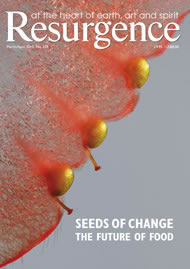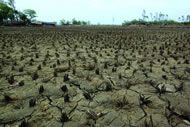Intensification of drought, floods and cyclones is one of the predictable impacts of climate change and climate instability. The failure of monsoon in India, and the consequent drought, has impacted two-thirds of the country, especially the breadbasket of India’s fertile Gangetic plains. Bihar, for example, has had a 43% rainfall deficit, and the story is the same in many other parts of India.
In the final analysis, India’s food security rests on the monsoon. Monsoon failure and widespread drought imply a deepening of the already severe food crisis triggered by trade-liberalisation policies, which have made India the capital of hunger. They also imply a deepening of the water crisis.
The monsoons recharge the groundwater and surface-water systems. Since 1966, as a consequence of the introduction of the Green Revolution model of water-intensive chemical farming, India has over-exploited her groundwater, creating a water famine. The chemical monocultures of the Green Revolution use ten times more water than the biodiverse ecological farming systems.
In the 1970s, the World Bank gave massive loans to India to promote groundwater mining. It forced states like Maharashtra to stop growing water-prudent millets like jowar, which needs 300mm of water, and shift to water-guzzling crops such as sugar cane, which needs 2,500mm of water. In a region with 600mm of rainfall, this is a recipe for water famine.
A new study published in Nature magazine and led by Matthew Rodell of the NASA/Goddard Space Flight Center in Maryland shows that water levels in North India fell by 40mm between August 2002 and August 2008. And over the same period more than 109km3 of groundwater disappeared from aquifers, most of it extracted for chemical, Green Revolution-style farming.
Not only has chemical agriculture mined groundwater, but it has also mined soil fertility and contributed to climate change. Chemical fertilisers destroy the living processes of the soil and make soils more vulnerable to drought. Chemical fertilisers also produce nitrogen oxide, a greenhouse gas 300 times more potent than carbon dioxide.
The solution for the climate crisis, the food crisis and the water crisis is the same: biodiversity-based, organic farming systems.
Biodiverse ecological farms address the climate crisis by reducing emissions of greenhouse gases such as nitrogen oxide, and absorbing carbon dioxide in plants and in the soil. Biodiversity and compost-rich soils are the most effective carbon sinks. They also help adapt to climate change and drought by increasing organic matter, which increases the moisture-holding capacity of soil, and hence provides drought-proofing of agriculture.
Biodiverse organic farms increase food security by increasing the resilience and reducing the climate vulnerability of farming systems. They also enhance food security because they have a higher production of food and nutrition per acre than Green Revolution monocultures, which measure the yield of a cash-crop commodity, not the total food output, nor the nutritional quality of that food.
Biodiverse organic systems also address the water crisis. Firstly, production based on water-prudent crops such as millets reduces water demand. Secondly, organic systems use ten times less water than chemical systems. Thirdly, by transforming the soil into a water reservoir by increasing its organic matter content, biodiverse organic systems reduce irrigation demand and help conserve water in agriculture.
Maximising biodiversity and organic matter in the soil thus simultaneously increases climate resilience, food security and water security.
However, the dominant paradigm of agriculture based on the Green Revolution and genetic engineering is based on reducing biodiversity and reducing organic matter to promote monocultures based on intensive inputs of chemicals, water and fossil fuels. And as the multiple crises deepen because of these non-sustainable practices, corporations try and transform the crisis into new business and marketing opportunities. Examples include the patenting of climate-resilient traits that farmers have evolved over centuries and projecting this biopiracy as an ‘invention’.
In a recent article published in the Wall Street Journal, ‘Fight Droughts with Science’, Henry I. Miller, co-author of The Frankenfood Myth, stated: “The first drought-resistant crop, maize, is expected to be commercialised by 2012. If field testing goes well, India would be a potential market for this variety.” What Miller fails to mention is that India already has hundreds of thousands of drought-resistant crops.
These are the crops farmers are growing in times of drought. While cultivation of rice has gone down from 25.673 million ha to 19.13 million ha, the area under water-prudent drought-resistant nutritious crops has gone up from 15.325 million to 15.956 million ha. The biotechnology industry is clearly a laggard in breeding for drought resistance, compared to centuries of breeding by India’s farmers. Miller also fails to mention that the genetically engineered drought-resistant maize seed performs badly in normal years. This is not science.
Another example of corporate opportunism in this period of drought is the pushing of Roundup (a broad-spectrum herbicide). Roundup kills everything green other than one single crop and therefore destroys the biodiversity and organic matter that is needed to promote climate resilience, conserve water and increase food production.
It is vital that the government of India does not use this emergency of drought to act as a marketer of GM seeds and Roundup. The alternative is clear. It involves:
1. Conservation and large-scale distribution of the seeds of water-prudent crops.
2. The promotion of organic agriculture to increase climate resilience and food and water security.
3. Incentives to farmers to encourage a shift from water-guzzling Green Revolution agriculture to water-conserving biodiverse organic agriculture.
Farmers did not create the Green Revolution. They should not be punished for its consequences.







